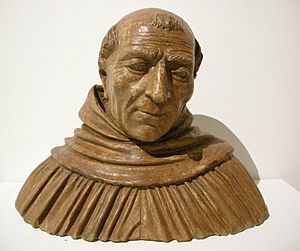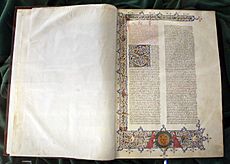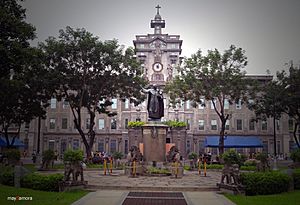Albertus Magnus facts for kids
Quick facts for kids SaintAlbertus Magnus OP |
|||||||
|---|---|---|---|---|---|---|---|

The Apparition of the Virgin to Saint Albert the Great by Vicente Salvador Gomez
|
|||||||
| Bishop of Regensburg Doctor of the Church |
|||||||
| Born | c. 1200 Lauingen, Duchy of Bavaria |
||||||
| Died | 15 November 1280 Cologne, Holy Roman Empire |
||||||
| Venerated in | Catholic Church | ||||||
| Beatified | 1622, Rome, Papal States by Pope Gregory XV | ||||||
| Canonized | 16 December 1931, Vatican City by Pope Pius XI | ||||||
| Major shrine | St. Andrew's Church, Cologne | ||||||
| Feast | 15 November | ||||||
| Attributes | Dominican habit, mitre, book, and quill | ||||||
| Patronage | Those who cultivate the natural sciences, medical technicians, philosophers, and scientists | ||||||
| Other names | Albertus Teutonicus, Albertus Coloniensis, Albert the Great, Albert of Cologne | ||||||
| Known for | Systematic study of minerals Discovery of the element arsenic |
||||||
| Scientific career | |||||||
| Fields | |||||||
|
Philosophy career |
|||||||
| Alma mater | University of Padua | ||||||
| Era | Medieval philosophy | ||||||
| Region | Western philosophy | ||||||
| School |
|
||||||
| Institutions | University of Paris | ||||||
| Doctoral advisor | Jordan of Saxony | ||||||
| Notable students | Thomas Aquinas, Petrus Ferrandi Hispanus | ||||||
|
Main interests
|
|||||||
|
Notable ideas
|
|
||||||
|
Influences
|
|||||||
|
Influenced
|
|||||||
|
|||||||
Albertus Magnus (born around 1200 – died November 15, 1280), also known as Saint Albert the Great, was an important German Dominican friar, philosopher, scientist, and bishop. He was later recognized as a Catholic saint. During his life, people called him Doctor universalis (meaning "Universal Teacher") and Doctor expertus (meaning "Expert Teacher"). Later, the name Magnus (meaning "the Great") was added to his name. Many scholars believe he was the greatest German philosopher and theologian of the Middle Ages. The Catholic Church honors him as one of the 37 Doctors of the Church.
Contents
Biography
Albert was likely born before the year 1200, possibly in Lauingen, which is now in Bavaria, Germany. He often referred to himself as 'Albert of Lauingen'. His family was probably of a middle-class background.
Albert probably studied at the University of Padua in Italy. There, he learned about the writings of Aristotle, a famous ancient Greek philosopher. In 1223 or 1229, he joined the Dominican Order, a group of Catholic priests and brothers. He then studied theology in Bologna and other places.
Albert became a teacher in Cologne, Germany, where the Dominicans had a house. He taught there for several years. He also taught in other cities like Regensburg, Freiburg, Strasbourg, and Hildesheim. In 1245, Albert became a master of theology, which allowed him to teach as a full professor at the University of Paris. During this time, Thomas Aquinas, another very famous philosopher and theologian, became one of Albert's students.
Albert was one of the first scholars to write comments on almost all of Aristotle's works. This made Aristotle's ideas available to many more people for study and discussion. He also studied and commented on the ideas of Muslim scholars like Avicenna and Averroes.
In 1254, Albert became the leader of the Dominican Order in his region. He worked hard to defend the Dominicans against criticism from other teachers at the University of Paris.
In 1260, Pope Alexander IV made Albert the bishop of Regensburg. He held this important position for three years. He was known for being humble and often walked long distances across his large diocese instead of riding a horse. In 1263, Pope Urban IV asked him to preach about the Eighth Crusade in German-speaking countries.
Albert was also known for helping to solve disagreements between different groups. In Cologne, he helped end a conflict between the citizens and the archbishop in 1258. He also defended the teachings of his former student, Thomas Aquinas, after Aquinas's death in 1274.
Albert was a true "universal scholar" – a scientist, philosopher, astrologer, theologian, and diplomat. He helped shape what Dominican students learned, bringing Aristotle's ideas into their studies.
He became ill in 1278 and died on November 15, 1280, in a Dominican convent in Cologne, Germany. His remains are now in a Roman sarcophagus in the crypt of St. Andrew's Church, Cologne.
Albert was declared "blessed" in 1622. He was made a saint and a Doctor of the Church on December 16, 1931, by Pope Pius XI. In 1941, he was named the patron saint of natural scientists. Saint Albert's feast day is November 15.
Writings and Discoveries
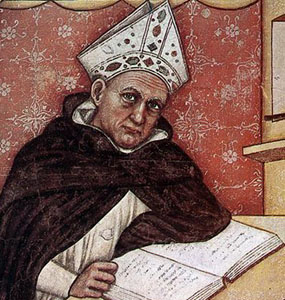
Albert wrote a huge amount! His collected writings from 1899 fill thirty-eight volumes. These books show his amazing knowledge of many subjects. These include logic, theology, botany (plants), geography, astronomy, astrology, mineralogy (minerals), alchemy, zoology (animals), and physiology (how living things work).
He studied, explained, and organized all of Aristotle's works. He used Latin translations and notes from Arabian scholars. Much of what we know today about Aristotle was saved and presented by Albert.
His main theological works include a commentary on the "Books of the Sentences" by Peter Lombard. He also wrote a two-volume work called Summa Theologiae.
Albert's work was often more about philosophy than theology. His philosophical writings are organized like Aristotle's sciences. They explain Aristotle's ideas and add discussions on topics of his time. Albert believed that Aristotle's way of studying nature did not conflict with a Christian view of the world.
Albert knew a lot about natural science, and his knowledge was very accurate for his time. He worked incredibly hard in every area. He not only wrote comments on Aristotle's scientific works but also added his own ideas and improved them. His books on botany, zoology, and minerals included information from ancient sources. But they also had results from his own experiments and observations. These studies helped push several sciences forward, beyond just relying on old texts. For example, in the study of how living things develop (embryology), it's said that little important work was done between Aristotle and Albert. Albert was able to identify organs inside eggs!
He even created entirely new fields of study where Aristotle hadn't covered a topic. For instance, before Albert, there was no organized study of minerals. Because of his wide range of achievements, he was given the name Doctor Universalis (Universal Teacher).
Many of Albert's specific scientific findings have been replaced by newer discoveries. However, his general approach to science was surprisingly modern. He believed that natural science should not just accept what we are told. Instead, it should "inquire into the causes of natural things."
Alchemy
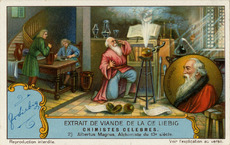
After Albert's death, many stories spread about him being an alchemist and a magician. However, many of the books about alchemy that were said to be by him were actually written by others. These authors falsely used Albert's name to make their own books seem more important.
In his real writings, Albert didn't say much about alchemy. When he did, it was usually in his comments on Aristotle. For example, in his book De mineralibus (On Minerals), he talks about the "power of stones," but he doesn't explain what these powers are.
However, Albert is credited with discovering the element arsenic. He also experimented with chemicals that react to light, like silver nitrate. He did believe that stones had hidden properties, as he wrote in De mineralibus. But there is little proof that he personally did many alchemy experiments.
A legend says that Albert discovered the philosopher's stone (a mythical substance that could turn ordinary metals into gold) and gave it to his student Thomas Aquinas just before he died. However, Thomas Aquinas died six years before Albert, so this specific legend is unlikely to be true. Albert himself never said he found the stone, but he did write that he saw gold being created by "transmutation" (changing one substance into another).
Astronomy
Albert was very interested in astronomy. During the Middle Ages, and for a long time after, many scientists believed in astrology. They thought that life on Earth was like a small copy of the universe (the cosmos). They believed that what happened in the sky affected things on Earth. So, it seemed logical that astrology could help predict a person's future.
Albert thought that understanding how the stars and planets influenced us could help us live better Christian lives. He wrote two main works about his astrological beliefs around 1260: the Speculum astronomiae and the De Fato. You can also find details of his beliefs in almost everything else he wrote.
Music
Albert also wrote about the music of his time. Most of his thoughts on music are in his comments on Aristotle's Poetics. He didn't believe in the idea of "music of the spheres" – the idea that planets make sounds as they move. He thought that the movement of astronomical bodies couldn't create sound.
He wrote a lot about how musical notes relate to each other. He also discussed how plainchant (a type of religious singing) could affect the human soul in three ways: by cleaning away impurities, by bringing understanding for deep thought, and by helping achieve perfection through contemplation. He also paid attention to silence as an important part of music, which is interesting to music theorists today.
Natural Law
Albert wrote about natural law and justice. He believed that God is the highest source of justice and natural law. God makes the rules, and divine authority is supreme. Until his time, his work was the only one specifically about natural law written by a theologian or philosopher.
Friendship
Albert discussed friendship in his work, especially in De bono and Super Ethica. He believed that friendship was a very important part of life. He agreed with the Roman writer Cicero, who said that "friendship is nothing other than the harmony between things divine and human, with goodwill and love." Albert added that this harmony is a special kind of movement within the human spirit.
Albert fully agreed with Aristotle that friendship is a virtue (a good quality). He described three levels of friendship:
- Friendship based on usefulness (amicitia utilis), where people are friends because they benefit from each other.
- Friendship based on pleasure (amicitia delectabilis), where people are friends because they enjoy each other's company.
- Friendship based on true goodness (amicitia honesti), which is the highest form of friendship, rooted in shared moral values.
Influence and Tribute
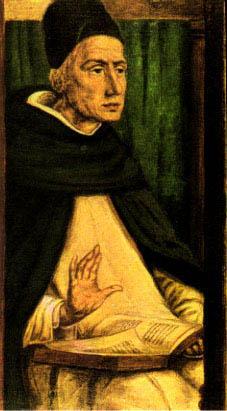
Many schools and buildings are named after Albertus Magnus to honor his contributions:
- Albertus Magnus High School in Bardonia, New York.
- Albertus Magnus College in New Haven, Connecticut.
- Albertus Magnus Science Hall at Thomas Aquinas College in Santa Paula, California.
- The main science buildings at Providence College and Aquinas College in Grand Rapids, Michigan.
- The central square at the University of Cologne campus has a statue of Albert and is named after him.
- The Academy for Science and Design in New Hampshire named one of its houses Magnus House.
- The University of Houston Law Center has a statue of Albert to honor his contributions to law.
- The Albertus-Magnus-Gymnasium is in Rottweil, Germany.
- The Albertus Magnus International Institute in Managua, Nicaragua, founded in 2004.
In the Philippines, the Albertus Magnus Building at the University of Santo Tomas is named after him. It houses several colleges and a high school. Saint Albert the Great Science Academy in San Carlos City, Pangasinan, and San Alberto Magno Academy in Tubao, La Union, are also named in his honor.
Because of his work in natural philosophy, several living things and even an asteroid are named after him:
- The bacterium Agrobacterium albertimagni.
- The plant species Alberta magna.
- The crustacean Bodigiella albertimagni.
- The fossil brachiopod Albasphe albertimagni.
- The asteroid 20006 Albertus Magnus.
Many Catholic elementary and secondary schools are named for him, including schools in Toronto, Calgary, Cologne, and Dayton, Ohio.
The Albertus typeface (a style of writing letters) is also named after him.
At the University of Notre Dame in Indiana, the Zahm Hall Chapel is dedicated to St. Albert the Great.
The second largest student fraternity in the Netherlands, in Groningen, is named Albertus Magnus.
The Colegio Cientifico y Artistico de San Alberto in Hopelawn, New Jersey, USA, was founded in 1986 in his honor. It teaches that religion, science, and arts can work together to achieve wisdom.
The Catholic parish in Vosloorus, South Africa, and the Catholic parish in Leopoldshafen, Germany, are also named after him.
Since the death of King Albert I, King's Feast in Belgium is celebrated on Albert's feast day.
Edinburgh's Catholic Chaplaincy for university students is named after St Albert.
Sant'Alberto Magno is a titular church in Rome.
See Also
 In Spanish: Alberto Magno para niños
In Spanish: Alberto Magno para niños
- Christian mysticism
- List of Catholic saints
- List of Roman Catholic scientist-clerics
- Saint Albert the Great, patron saint archive
- Science in the Middle Ages
Images for kids


